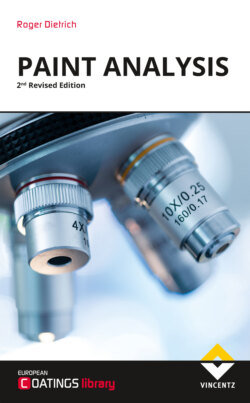Читать книгу Paint Analysis - Roger Dietrich - Страница 12
На сайте Литреса книга снята с продажи.
6Depth profiling
ОглавлениеThe imaging techniques enable the two-dimensional characterisation of a certain sample area in the uppermost plane. But some issues ask for analyses into the depth of the sample. Depending on the so-called information depth or penetrating depth of the applied method this allows for chemical information of the uppermost surface down 1 to 2 μm into the bulk.
Figure I.10: Information depth for selected methods
The information depth is the distance (measured down from the very top of the surface into the bulk) to the area inside the sample, where the information is generated that can be measured by the detector. Everything that lies deeper is not available from the top without sample preparation. But sometimes you might want to go deeper to understand what is happening for example 5 to 10 μm underneath the visible surface. The question is: how to achieve this goal with the minimum influence on the sample. SEM-EDS, for example, offers a limited variation of the information depth by adjusting the acceleration of the primary electrons that excite the sample surface. But the most attractive approach would be sputtering (“slicing”) the sample layer by layer from the top and analysing the surfaces as they become exposed. The TOF-SIMS method offers this mode. But the disadvantage of this process is that each sputtering process changes the surface in a way that most of the organic compounds are cracked or even destroyed. So, the target area is irreversibly modified before the information can be collected.
Figure I.11: Axial profiling of a coating layer from the surface down to the substrate by confocal design (focussing the exciting beam along the optical axis) (left) and lateral profiling of a cross section (right)
A non-destructive method is offered by the Confocal Raman Microscopy (see Chapter IV). With this method the sample is excited by a laser beam which is focussed to a very narrow so-called focal volume. By focussing the laser this vocal volume (about 1 μm3) is incrementally moved down from the surface into the bulk. This so-called axial profiling scans the chemical composition along the optical axis. So e.g. for a 5 μm layer of a primer on polymer substrate this is the only non-destructive way of characterizing the primer layer and the interface between primer and polymer substrate on a molecular basis.
The most commonly used method of gathering information about deeper layers is lateral profiling of a polished cross section. The sample is embedded into a resin, sectioned perpendicular to the surface, grinded and polished achieving a cross section surface that can be analysed by different techniques subsequently.
